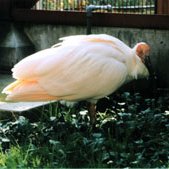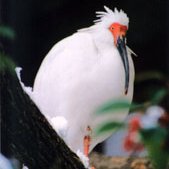

 |
||

|
Preserving an Endangered Bird on the Verge
of Extinction
  The Toki (Japanese Crested Ibis) goes by the scientific name Nipponia nippon. In the past, this magnificent bird could be seen in all parts of Japan, but due to overhunting and environmental pollution in the early 20th century its number plunged until only few remained. The Toki is now on the verge of extinction. In 1952 the species was designated a Special Natural Monument, and in 1960 it was listed as an internationally protected species. Despite strenuous efforts at captive breeding, there is only one surviving native-born example of the species in Japan; this is a 25-year-old female bird named Kin which is cared for at the Toki Preservation Center on Sado Island in Niigata Prefecture. The bird was believed to have died out everywhere except
in Japan, but in 1981 it was confirmed that 12 specimens were living in
China. Breeding efforts paid off and the population increased year by year,
to 85 birds as of July 1996. Japan and China have also been working closely
to conserve the bird. For example, Japan received a male ibis on loan,
in exchange for the training of Chinese breeding experts and the provision
of equipment and materials for China. Unfortunately, Midori, the sole surviving
native male Toki, died in April 1995.
When fully grown the Toki stands about 75 centimeters (29.5 inches) tall. Its head and legs are red, and at the top of the head are feathers that, when they stand up, form a crown-like crest. Covered with a veil of pinkish white feathers the bird is very colorful. At the Toki Preservation Center the staff are still working hard to prolong the life of the last remaining example of this species. Photos: (Top left) "Kin," the last Japanese toki; (top right) "Midori," the last native male toki, died in 1995; (bottom) "Midori" (right) and "Kin." (Sado Toki Conservation Center) Unauthorized reproduction of the
photos in this page is prohibited.
Related Links: |
|

